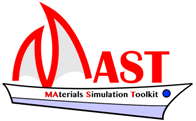8.7. The Defects section¶
The $defects section specifies defects by:
- defect type:
- vacancy
- interstitial
- substitution or antisite
- defect coordinates
- defect element symbol
- Note that if an
elementmapsubsection is given in The Structure section, then the mapped designationsX1,X2, and so on can be given instead of an element symbol.
- Note that if an
ATTENTION:
- Elements in the initial structure, given in The Structure section, will appear in order as entered, by posfile keyword or through the coordinates and/or elementmap subsections.
- However, once a defect is formed, structures are RESORTED by element ELECTRONEGATIVITY. Therefore, if you are using substitutional defects or non-self-interstitials, you may find that later element-specific keywords (mast_setmagmom, LDAUU, LDAUJ) may be OUT OF ORDER FOR YOUR DEFECTED STRUCTURE.
- Please check your files carefully! You may want a separate input file for each chemical system (possibly created through looping (see Input File) in order to synchronize the elements and element-specific keywords.
The coord_type keyword specifies fractional or cartesian coordinates for the defects.
The threshold keyword specifies the absolute threshold for finding the defect coordinate, since relaxation of the perfect structure may result in changed coordinates.
Example $defects section:
$defects
coord_type fractional
threshold 1e-4
vacancy 0 0 0 Mg
vacancy 0.5 0.5 0.5 Mg
interstitial 0.25 0.25 0 Mg
interstitial 0.25 0.75 0 Mg
$end
The above section specifies 4 point defects (2 vacancies and 2 interstitials) to be applied separately and independently to the structure. When combined with the correct recipe in The Recipe section, four separate ingredients, each containing one of the defects above, will be created.
Multiple point defects can be also grouped together as a combined defect within a <defect label> subsection such as:
$defects
coord_type fractional
threshold 1e-4
begin doublevac
vacancy 0.0 0.0 0.0 Mg
vacancy 0.5 0.5 0.5 Mg
end
interstitial 0.25 0.25 0 Mg
interstitial 0.25 0.75 0 Mg
$end
In this case, there will be three separate defect ingredients: one ingredient with two vacancies together (where the defect group is labeled doublevac), one interstitial, and another interstitial.
8.7.1. Charges for defects¶
Charges can be specified as charge=0,10, where a comma denotes the lower and upper ranges for the charges.
Let’s say we want a Mg vacancy with charges from 0 to 3 (0, 1, 2, and 3):
vacancy 0 0 0 Mg charge=0,3
Let’s say we want a dual Mg vacancy with a charge from 0 to 3 and labeled as Vac@Mg-Vac@Mg:
begin Vac@Mg-Vac@Mg
vacancy 0.0 0.0 0.0 Mg
vacancy 0.5 0.5 0.5 Mg
charge=0,3
end
For a single defect, charges and labels can be given at the same time:
Let’s say we have a Mg vacancy with charges between 0 and 3, and we wish to label it as Vac@Mg:
vacancy 0.0 0.0 0.0 Mg charge=0,3 label=Vac@Mg
The charge and label keywords are interchangeable, i.e. we could also have typed:
vacancy 0 0 0 Mg label=Vac@Mg charge=0,3
If you use charges in the defects section like this, then you must use a tagged defect_<N>_<Q> type recipe in The Recipe section.
8.7.2. Phonons for defects¶
Phonon calculations are described by a phonon center site coordinate and a phonon center radius (uses pymatgen’s find_in_coord_list_pbc method for radial tolerance). Atoms within the sphere specified by these two values will be included in phonon calculations.
For VASP, this inclusion takes the form of selective dynamics T T T for the atoms within the sphere, and F F F otherwise, in a phonon calculation (IBRION = 5, 6, 7, 8)
If the phonon center radius is 0, only the atom found at the phonon center site point will be considered.
To use phonons in the defects section, use the subsection keyword phonon followed by:
- A label for the phonon
- The fractional coordinates for the phonon center site
- A float value for the phonon center radius
- An optional float value for the tolerance-matching threshold for matching the phonon center site (if this last value is not specified, 0.1 is used). Only used if atom indexing is not used.
If atom indexing is used, only the phonon center site and phonon center radius are used, with an additional 0.0001 matching tolerance.
Multiple separate phonon calculations may be obtained for each defect, for example:
begin int1
interstitial 0.25 0.25 0.25 X2
phonon host3 0.3 0.3 0.4 0.25 0.01
phonon solute 0.1 0.1 0.2 0.05
end
In the example above, host3 is the label for the phonon calculation where (0.3, 0.3, 0.4) is the coordinate for the phonon center site, and 0.25 is the fractional radius for the sphere inside which to consider atoms for the phonon calculation. Points within 0.01 of fractional coordinates will be considered for matching the phonon center site, if atom indexing is not used.
In the example above, solute is the label for the phonon calculation bounded within a 0.05 fractional radius centered at (0.1, 0.1, 0.2) in fractional coordinates. As no threshold value was given, points within 0.1 (default) of fractional coordinates will be considered for matching the phonon center site, if atom indexing is not used.
The recipe template file for phonons may include either the explicit phonon labels and other labels, or <S>, <N>, <Q>, <P>. See The Recipe section.
Because phonons are cycled with the defects, a new parent loop must be provided for the phonons, for example:
{begin}
defect_<N>_<Q>_stat (static)
phonon_<N>_<Q>_<P> (phonon)
phonon_<N>_<Q>_<P>_parse (phononparse)
{end}
